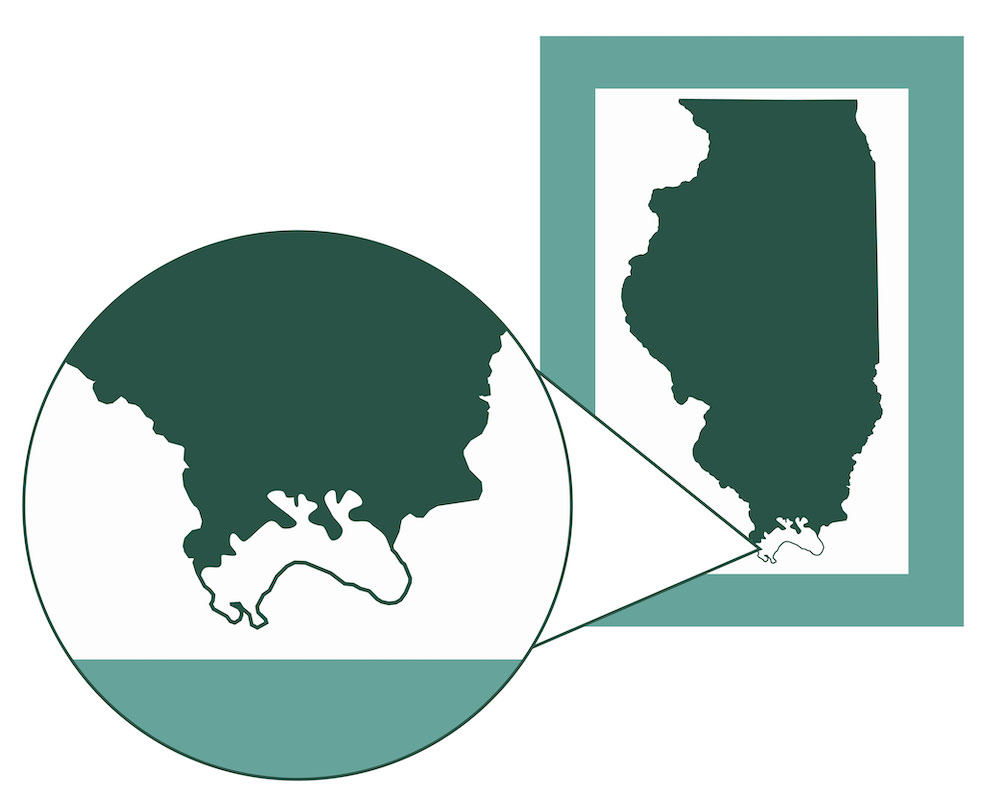
Photos by Hannah Holmquist.



Photos by Hannah Holmquist.
While surveying fish at Buttonland Swamp in southern Illinois, Hannah Holmquist discovered an aquatic creature she had never seen before. It was a 2-inch-long fish that displayed some red markings and had a dark spot near the rear fin.

She keyed it out and it was later confirmed by a biologist that this was the taillight shiner, thought to have been extirpated from the state, meaning none were living in the wild.
“I was ecstatic,” said Holmquist, a graduate research assistant at Southern Illinois University’s Center for Fisheries, Aquaculture and Aquatic Sciences. “This taillight shiner (Notropis maculatus) only lives for about a year in the wild and doesn’t get much bigger than 2 or 3 inches.”
“This rediscovery clarifies that we need to continue to protect it,” said Brian Metzke, a stream ecologist for the Illinois Department of Natural Resources (IDNR), which owns and manages Buttonland Swamp.
“It’s absolutely beautiful,” Metzke said of the swamp. “It harbors so many endangered and otherwise imperiled species. The rediscovery of the taillight shiner just adds to the diversity and the uniqueness of the place.”
Since she began her graduate research project in June of 2020, a research project funded by a State Wildlife Grant T-130-R-1 Illinois Wildlife Action Plan, Holmquist has visited the roughly 500-acre swamp nearly every month to survey fish. The swamp contains flowing water through a forest of bald cypress, tupelo trees, buttonbush and other vegetation.
After rediscovering the taillight shiner in September 2020, she’s found at least one or two individuals nearly every time she has surveyed the swamp.
“It really is a beautiful little fish,” Holmquist said. “When they’re spawning, the males get really red.” During one of her surveys she discovered a bright red male and female bulging with eggs.
“I just love unique fish like the tiny taillight shiners,” she said. “There’s such diversity of fish in the swamp.”
Buttonland Swamp is protected as part of the Lower Cache River Land and Water Reserve which is owned by the IDNR. Twelve state-threatened or -endangered plant and animal species have been recorded there. Eleven fish species listed as Species in Greatest Conservation Need have been recorded in Buttonland Swamp.

The swamp is within the Cache River State Natural Area, which covers nearly 15,000 acres in Johnson, Massac and Pulaski counties.
Metzke said the shiner was found in Illinois in the late 1980s by Brooks M. Burr, emeritus professor of zoology at Southern Illinois University at Carbondale.
A coeditor of “Freshwater Fishes of North America,” Burr “is one of the best ichthyologists in the state and is very familiar with southern Illinois fishes,” Metzke said. “He knew that this species existed in Kentucky, and that it never had been discovered in Illinois.”
Burr found the taillight shiner in a small creek in Massac County, Metzke noted. “In general, these fish like small streams of backwaters and swamps, typically around vegetation or with debris. Illinois is at the northern end of its range.”
For three decades, biologists searched in vain for the species, which had been declared an Illinois endangered species. None were found until Holmquist rediscovered the species close to where Burr had found it in the 1980s.
Metzke said he’s guessing the fish have always been there. “They like to hide deep in the vegetation. We’ve done surveys there, but we may have just missed it,” he explained.
Holmquist also found the fish with a different type of sampling other than casting a net into the water to capture fish and identify them.
Instead, “I send electric current into the water that shocks the fish temporarily,” Holmquist said. “They float up to the top. I catch and measure the fish then release them. They swim off, unharmed by the procedure.”

Metzke said the IDNR has been managing the swamp and other ecosystems within the land and water reserve with dredging, invasive-species control, monitoring and water-level manipulation.
“In the early 1900s the swamp had nearly been drained due to erosion from nearby agricultural lands and other sources,” Metzke said. “We now manage it to maintain water in the system year-round. Amphibians, snakes, fish and birds depend on that.”
Holmquist will continue to survey the swamp for fish species for another year or more until she completes her graduate research project. “I am finding taillight shiners throughout the swamp where there is a lot of buttonbush and scattered tupelo and cypress trees,” she explained.
The fish, which eat algae, crustaceans and aquatic critters, spawn in spring and early summer. The female lays roughly 70 to 400 eggs.
“The shiners like turbid water that you can’t really see through,” Holmquist said. “This could be why some young escape predation—predators simply have trouble seeing the fish.”
Holmquist said having the taillight shiner as part of the menagerie of plants and animals at Buttonland Swamp maintains diversity, which in turn maintains a healthy ecosystem.
“Everything is connected,” she said. “When a species is extirpated from its natural habitat we really don’t know how that will affect the whole community.”
As she continues surveying the swamp, Holmquist hopes to collect more data that will help IDNR better understand the specific habitats the taillight shiners prefers.
Documenting the taillight shiner and other fish is worth the many hot summer days Holmquist has spent in the swamp. Even the days her boat gets stuck on bald cypress knees.
Sheryl DeVore writes environment and nature pieces for regional and national publications and has had several books published, including “Birds of Illinois” co-authored with her husband, Steven D. Bailey.
Submit a question for the author